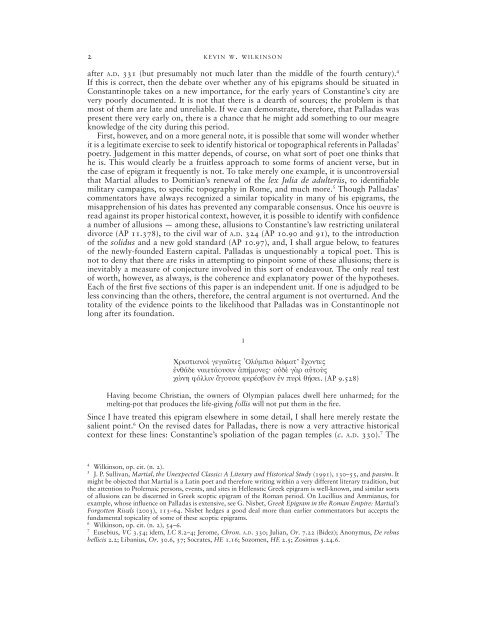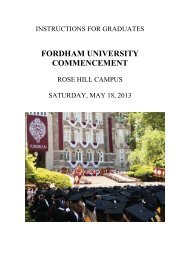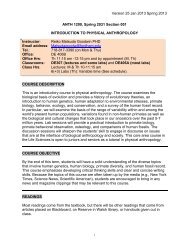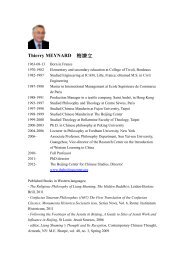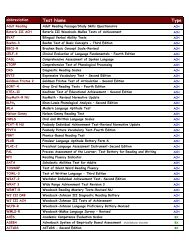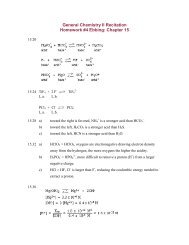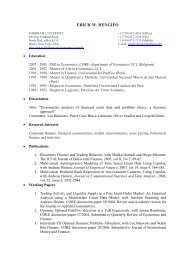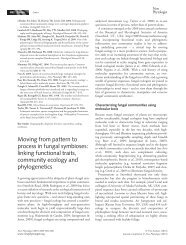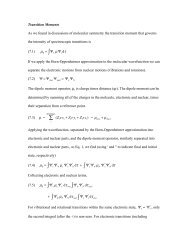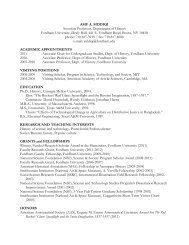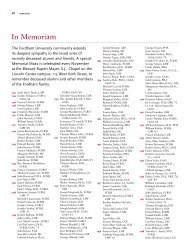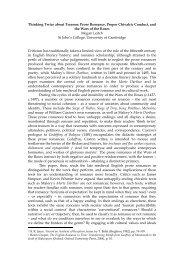Palladas and the Foundation of Constantinople - Fordham University
Palladas and the Foundation of Constantinople - Fordham University
Palladas and the Foundation of Constantinople - Fordham University
Create successful ePaper yourself
Turn your PDF publications into a flip-book with our unique Google optimized e-Paper software.
2 K E V I N W. WILKINSON<br />
after A.D. 331 (but presumably not much later than <strong>the</strong> middle <strong>of</strong> <strong>the</strong> fourth century). 4<br />
If this is correct, <strong>the</strong>n <strong>the</strong> debate over whe<strong>the</strong>r any <strong>of</strong> his epigrams should be situated in<br />
<strong>Constantinople</strong> takes on a new importance, for <strong>the</strong> early years <strong>of</strong> Constantine’s city are<br />
very poorly documented. It is not that <strong>the</strong>re is a dearth <strong>of</strong> sources; <strong>the</strong> problem is that<br />
most <strong>of</strong> <strong>the</strong>m are late <strong>and</strong> unreliable. If we can demonstrate, <strong>the</strong>refore, that <strong>Palladas</strong> was<br />
present <strong>the</strong>re very early on, <strong>the</strong>re is a chance that he might add something to our meagre<br />
knowledge <strong>of</strong> <strong>the</strong> city during this period.<br />
First, however, <strong>and</strong> on a more general note, it is possible that some will wonder whe<strong>the</strong>r<br />
it is a legitimate exercise to seek to identify historical or topographical referents in <strong>Palladas</strong>’<br />
poetry. Judgement in this matter depends, <strong>of</strong> course, on what sort <strong>of</strong> poet one thinks that<br />
he is. This would clearly be a fruitless approach to some forms <strong>of</strong> ancient verse, but in<br />
<strong>the</strong> case <strong>of</strong> epigram it frequently is not. To take merely one example, it is uncontroversial<br />
that Martial alludes to Domitian’s renewal <strong>of</strong> <strong>the</strong> lex Julia de adulteriis, to identifi able<br />
military campaigns, to specifi c topography in Rome, <strong>and</strong> much more. 5 Though <strong>Palladas</strong>’<br />
commentators have always recognized a similar topicality in many <strong>of</strong> his epigrams, <strong>the</strong><br />
misapprehension <strong>of</strong> his dates has prevented any comparable consensus. Once his oeuvre is<br />
read against its proper historical context, however, it is possible to identify with confi dence<br />
a number <strong>of</strong> allusions — among <strong>the</strong>se, allusions to Constantine’s law restricting unilateral<br />
divorce (AP 11.378), to <strong>the</strong> civil war <strong>of</strong> A.D. 324 (AP 10.90 <strong>and</strong> 91), to <strong>the</strong> introduction<br />
<strong>of</strong> <strong>the</strong> solidus <strong>and</strong> a new gold st<strong>and</strong>ard (AP 10.97), <strong>and</strong>, I shall argue below, to features<br />
<strong>of</strong> <strong>the</strong> newly-founded Eastern capital. <strong>Palladas</strong> is unquestionably a topical poet. This is<br />
not to deny that <strong>the</strong>re are risks in attempting to pinpoint some <strong>of</strong> <strong>the</strong>se allusions; <strong>the</strong>re is<br />
inevitably a measure <strong>of</strong> conjecture involved in this sort <strong>of</strong> endeavour. The only real test<br />
<strong>of</strong> worth, however, as always, is <strong>the</strong> coherence <strong>and</strong> explanatory power <strong>of</strong> <strong>the</strong> hypo<strong>the</strong>ses.<br />
Each <strong>of</strong> <strong>the</strong> fi rst fi ve sections <strong>of</strong> this paper is an independent unit. If one is adjudged to be<br />
less convincing than <strong>the</strong> o<strong>the</strong>rs, <strong>the</strong>refore, <strong>the</strong> central argument is not overturned. And <strong>the</strong><br />
totality <strong>of</strong> <strong>the</strong> evidence points to <strong>the</strong> likelihood that <strong>Palladas</strong> was in <strong>Constantinople</strong> not<br />
long after its foundation.<br />
I<br />
Χριστιανοὶ γεγαῶτες Ὀλύμπια δώματ’ ἔχοντες<br />
ἐνθάδε ναιετάουσιν ἀπήμονες· οὐδὲ γὰρ αὐτοὺς<br />
χώνη φόλλιν ἄγουσα φερέσβιον ἐν πυρὶ θήσει. (AP 9.528)<br />
Having become Christian, <strong>the</strong> owners <strong>of</strong> Olympian palaces dwell here unharmed; for <strong>the</strong><br />
melting-pot that produces <strong>the</strong> life-giving follis will not put <strong>the</strong>m in <strong>the</strong> fi re.<br />
Since I have treated this epigram elsewhere in some detail, I shall here merely restate <strong>the</strong><br />
salient point. 6 On <strong>the</strong> revised dates for <strong>Palladas</strong>, <strong>the</strong>re is now a very attractive historical<br />
context for <strong>the</strong>se lines: Constantine’s spoliation <strong>of</strong> <strong>the</strong> pagan temples (c. A.D. 330). 7 The<br />
4 Wilkinson, op. cit. (n. 2).<br />
5 J. P. Sullivan, Martial, <strong>the</strong> Unexpected Classic: A Literary <strong>and</strong> Historical Study (1991), 130–55, <strong>and</strong> passim. It<br />
might be objected that Martial is a Latin poet <strong>and</strong> <strong>the</strong>refore writing within a very different literary tradition, but<br />
<strong>the</strong> attention to Ptolemaic persons, events, <strong>and</strong> sites in Hellenstic Greek epigram is well-known, <strong>and</strong> similar sorts<br />
<strong>of</strong> allusions can be discerned in Greek scoptic epigram <strong>of</strong> <strong>the</strong> Roman period. On Lucillius <strong>and</strong> Ammianus, for<br />
example, whose infl uence on <strong>Palladas</strong> is extensive, see G. Nisbet, Greek Epigram in <strong>the</strong> Roman Empire: Martial’s<br />
Forgotten Rivals (2003), 113–64. Nisbet hedges a good deal more than earlier commentators but accepts <strong>the</strong><br />
fundamental topicality <strong>of</strong> some <strong>of</strong> <strong>the</strong>se scoptic epigrams.<br />
6 Wilkinson, op. cit. (n. 2), 54–6.<br />
7 Eusebius, VC 3.54; idem, LC 8.2–4; Jerome, Chron. A.D. 330; Julian, Or. 7.22 (Bidez); Anonymus, De rebus<br />
bellicis 2.2; Libanius, Or. 30.6, 37; Socrates, HE 1.16; Sozomen, HE 2.5; Zosimus 5.24.6.


